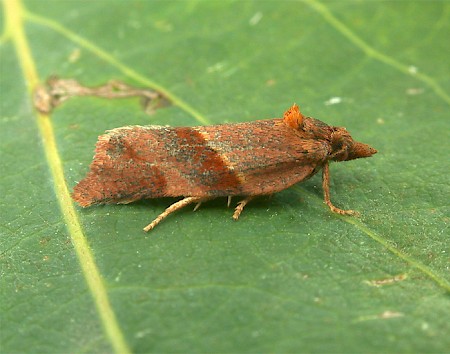49.008 BF1008
Philedone gerningana
([Denis & Schiffermüller], 1775)
Wingspan 13-16 mm.
The males of this species are generally broader-winged than the females, and show a rather more marked distinction between the outer and inner halves of the forewing.
It is usually found in wild uncultivated places, often, but not always, upland, including bogs, acid heaths and limestone outcrops. It occurs in most of the upland areas of the British Isles.
The moths fly from late June until August or September, the males flying during the day, and the females from dusk onwards.
The larvae feed on a range of plants and shrubs, in spun leaves or flowers.
Similar species:
The male superficially resembles some forms of the increasingly abundant alien, Epiphyas postvittana, but the tectiform (tent shape) wing posture and bipectinate-ciliate antennae of the male P. gerningana distinguish it. Captures in garden light traps are unlikely to be P. gerningana.
Larva: (description Ian F. Smith)
Foodplant: Polyphage in uncultivated habitats, in spun leaves and flowers, including Sorbus aucuparia, Teucrium scorodonia and (BTS) Potentilla, Helianthemum, Vaccinium, Armeria and Picea.
Length: 16 mm off Teucrium scorodonia described. (15 mm, off Sorbus aucuparia, variations in brackets, possibly due to diet rather than instar.)
Head: Gold ochre with burnt ochre areas on posterior half. Black posterolateral mark. Anterior edge of labrum reddish brown. Stemmatal area pitchy black.
Prothoracic shield: Transparent tinted yellow. Divided by paler fine median line. A few small brown spots laterally and bordering the anterior of the median line.
Thoracic legs: Base and basal half of femur coloured as body. Distally, femur encircled by broad dark brown band. Tibia mid brown, paler than femur band. Tarsus pitchy brown, the darkest part of the leg. (15 mm similar, but all colours darker.)
Body: Densely shagreened with fine granules. Olive green (15 mm, charcoal grey, olive intersegmentally). Paler ventrally. Contractile dorsal vessel shows as indistinct green dorsal line (15 mm, blackish dorsal line).
Spiracles: Small. Pitchy brown peritreme.
Pinacula: Grey with a fine black setal spot. Slightly darker than integument. (15 mm, slightly paler than integument.) Most fully developed on segments T2, T3 and A9.
Setae: Long, fine, colourless and transparent.
Anal segment: Anal comb of about six prongs, pale straw, darker distally.
Anal plate: Anterior third, dark green bearing black spots arranged in a 'U' subdorsally and a pair laterally. Central third, yellowish . Posterior third, pitchy brown, interrupted medially by two prongs of yellowish colour extending from central third of plate. The overall effect is of a pale 'Hercules' with outstretched legs and arms, and massive biceps.
(15 mm, similar pattern, but darker.)
Prolegs: Coloured as venter. Planta paler and translucent. Blackish lateral sclerite on anal proleg. Crochets reddish brown.

 UKMoths
UKMoths 



